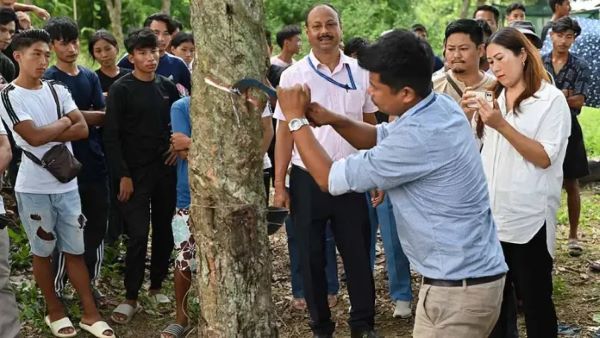
The Executive Director of the Rubber Board of India, M. Vasanthagesan, inaugurated Nagaland's first Rubber Tapping Training Centre on Saturday, at TOKA MPCS Ltd. in Ikishe village. This centre is set to play a crucial role in tapping into the state's vast rubber resources and creating new employment opportunities.
Managing Director and Secretary of Toka MPCS Ltd., K. Kathi Chishi, welcomed the attendees at the inauguration ceremony. Chishi highlighted the significant impact of the rubber project, noting that it has already provided permanent employment to 175 Naga youth across various districts. He emphasized that the training program will last for eight days and will offer free accommodation, meals, and lodging. Trainers from the Rubber Board will deliver comprehensive training to equip participants with essential skills and knowledge for effective rubber tapping.
Chishi also pointed out that approximately 30 million rubber trees remain untapped in Nagaland, which is a massive potential for employment and economic growth. In his address, Executive Director M. Vasanthagesan traced the Rubber Board's history back to its establishment in April 1947. He noted that in 1948, India produced only about 20,000 tonnes of latex annually, whereas the previous year saw a production of 8.57 lakh tonnes. Despite this growth, the domestic demand, driven by the tyre and non-tyre industries, stood at 14.16 lakh tonnes, necessitating imports to meet the shortfall. This gap underscores the vast potential for further growth in India's rubber industry, he added.
Vasanthagesan mentioned that there are approximately 13 lakh rubber growers in India, with Kerala and Tripura being the top producers. He highlighted that Nagaland has the potential to follow in Tripura's footsteps, given its untapped rubber plantations spread across over 10,000 hectares in various districts. He said that the new training program aims to tap these resources scientifically and professionally, thereby boosting local production and contributing to the region's socio-economic development.
Vasanthagesan also outlined two critical initiatives for Nagaland's rubber industry. The first is the ongoing expansion of new rubber plantations in partnership with the tyre industry. The second involves the untapped 17,000 hectares of rubber plantations. By expanding rubber cultivation, training tappers, and fostering local partnerships, Nagaland can harness its rubber resources to generate substantial employment and bolster its economic development, he added